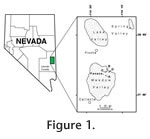| |
INTRODUCTION
 The Panaca local fauna (l.f.) described by
Chester Stock (1921) is located in Meadow Valley, south of Panaca in Lincoln County, southeastern Nevada (Figure 1). Stock named the sediments the Panaca Formation. The fossils from Panaca described by Stock include Pliohippus sp., ?Teleoceras sp., and Pliauchenia (now considered Hemiauchenia), genera that were generally assigned to the Hemphillian North American Land Mammal Age (NALMA), although precise age of the Panaca l.f. was questionable (Stirton 1940;
Macdonald and Pelletier 1956). Later, G.E. Hazen and H.S. Gentry, working for the Frick Laboratory of the American Museum of Natural History (F:AM) during the 1940s, collected more fossils from Meadow Valley, noting that most of the fossils they found from the Panaca area were younger than the fossils collected earlier by Stock. Later still, both small and large mammals were collected by T. Galusha and R. Emry, working for the American Museum of Natural History (AMNH). Some of those fossils were described by
May (1981),
Repenning (1987), and
White (1987,
1991).
Mou (1997) described a new species of arvicolid rodent from the Panaca l.f., and later
(1998) described the enamel schmelzmuster of the new arvicolid rodent. Virtually all of these small mammals collected from the Panaca area are indicative of Blancan NALMA. More recently,
Lindsay et al. (2002) resumed collection of small mammals in Meadow Valley, placing them in a magnetostratigraphic framework to shed light on placement of the Hemphillian/Blancan boundary in these deposits, and concluding that they are of Blancan NALMA. The Panaca local fauna (l.f.) described by
Chester Stock (1921) is located in Meadow Valley, south of Panaca in Lincoln County, southeastern Nevada (Figure 1). Stock named the sediments the Panaca Formation. The fossils from Panaca described by Stock include Pliohippus sp., ?Teleoceras sp., and Pliauchenia (now considered Hemiauchenia), genera that were generally assigned to the Hemphillian North American Land Mammal Age (NALMA), although precise age of the Panaca l.f. was questionable (Stirton 1940;
Macdonald and Pelletier 1956). Later, G.E. Hazen and H.S. Gentry, working for the Frick Laboratory of the American Museum of Natural History (F:AM) during the 1940s, collected more fossils from Meadow Valley, noting that most of the fossils they found from the Panaca area were younger than the fossils collected earlier by Stock. Later still, both small and large mammals were collected by T. Galusha and R. Emry, working for the American Museum of Natural History (AMNH). Some of those fossils were described by
May (1981),
Repenning (1987), and
White (1987,
1991).
Mou (1997) described a new species of arvicolid rodent from the Panaca l.f., and later
(1998) described the enamel schmelzmuster of the new arvicolid rodent. Virtually all of these small mammals collected from the Panaca area are indicative of Blancan NALMA. More recently,
Lindsay et al. (2002) resumed collection of small mammals in Meadow Valley, placing them in a magnetostratigraphic framework to shed light on placement of the Hemphillian/Blancan boundary in these deposits, and concluding that they are of Blancan NALMA.
This report describes and places the small mammals of the Panaca l.f. in the evolutionary-chronologic context of Meadow Valley sediments, framed in the earlier chronological study of the Panaca Fm. (Lindsay et al. 2002).
|